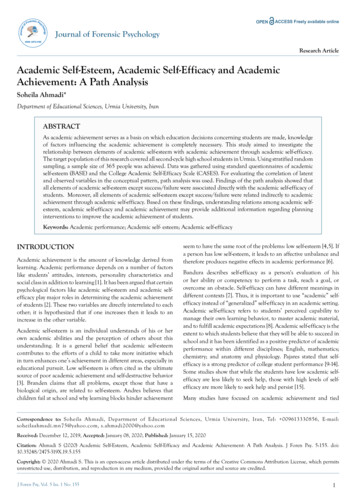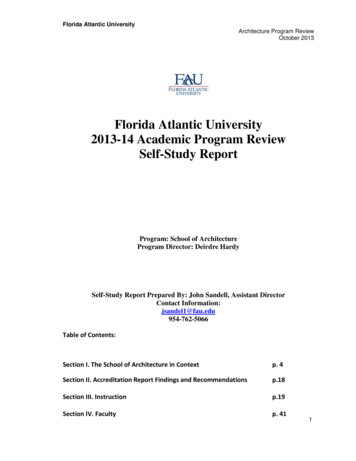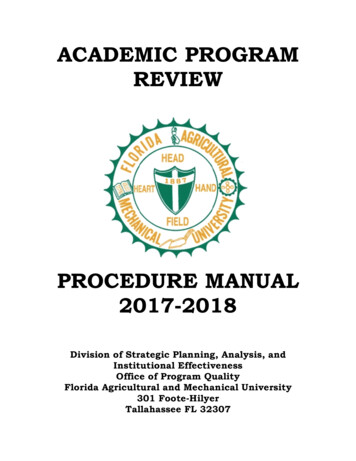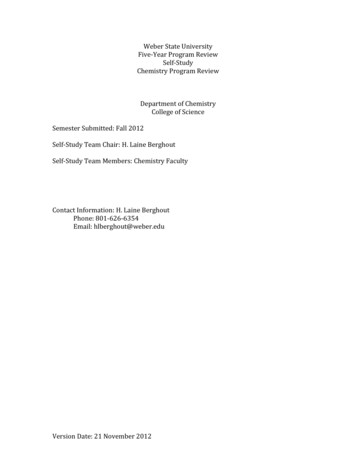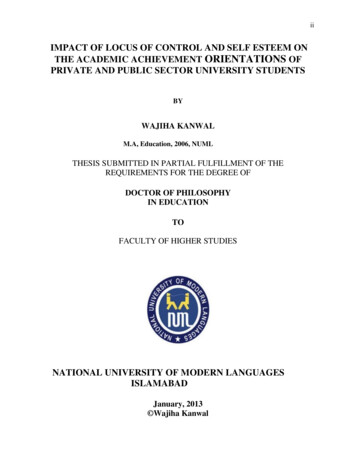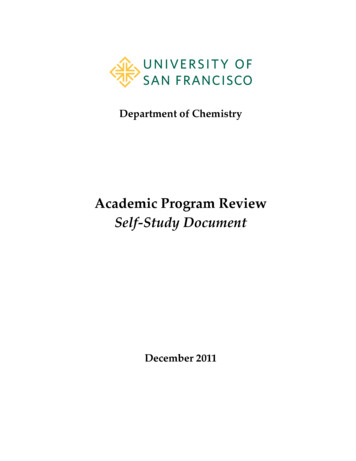
Transcription
Department of ChemistryAcademic Program ReviewSelf-Study DocumentDecember 2011
IntroductionMission (approved Fall 2011)HistoryThe FacultyRecommendations and response to 2005 outside reviewCurriculumIntroductionUndergraduate Program: Course descriptionsHonor and awards available to undergraduate majorsMS ProgramMission, Background, Admission and Student Financial SupportProgram requirements, departmental resourcesMS StudentsUndergraduate AdvisingAssessmentBS Program Learning Goals (2011- ):BS Program Learning Outcomes and Methods (2011- ):MS Program Learning Outcomes and 181919212222232324242729Departmental Governance29Students29Staff30Diversity and Internationalization31Technology/ITS support/Library31Facilities31Conclusions to the Self Study Report32Plan for future33Appendices34Survey of alumniSummary of support in other MS programsBS/MS Assessment reports (samples)Department policies and bylaws34404150USF Chemistry 2
Academic Program Review: Self Study:USF Chemistry Department, Fall 2011I.IntroductionA. Mission (approved Fall 2011)The Mission of the Chemistry Program at USF is to deliver a broad-based, challenging chemical experiencethat will train students to participate effectively as professionals in a variety of careers including graduateprograms, health professions, government or private industry and teaching. The program will foster aculture that: values strong student-faculty-staff interactions and strives to help students become selflearners, creates opportunities for students to discover the excitement and creativity of chemical research,and values an understanding of social responsibility with ethical behavior as part of a chemical community.B. HistoryThe Department of Chemistry has been offering an ACS accredited degree in chemistry for over 45 yearsand an ACS degree with a concentration in biochemistry for over 20 years. In addition, it offers minorprograms in both chemistry and biochemistry. For the past 55 years, USF has maintained an active,laboratory/thesis based, Masters Degree program. The MS students are integrated into research projects andare supported by TA salaries in undergraduate lab sections with wavier of tuition. Introductory courses serveboth our majors and biology, exercise and sports science and environmental science students, but no longerserves nursing students. USF does not have any engineering programs on campus. In the past 10-15 years,the department has delivered many different general education or "core" courses for the non science majorthat help students understand the nature of the physical world, the uses of the scientific method, and theimplications of technology.Since the last review, four faculty searches lead to hiring two new tenure track assistant professors (one waslet go, one search failed), many new instruments were purchased via external grants and foundations, andthere were significant staff changes as we are on our third administrative assistant, second stockroommanager (a new full time position) and second lab coordinator (new full time position). The chemistrymajors and minors were streamlined to fit the 4-unit system at USF, resulting in fewer units in requiredcourses to allow chemistry electives and undergraduate research (required for ACS certified majors).Finally, all prerequisite grades for our courses was raised to C from C- in 2010 after examination of thefailure/withdrawal rates in Physical Chemistry courses, especially. The department is generally enthusiasticabout these later changes and other changes to spread out the workload (especially lab sections) among allthe faculty. We are already seeing new ideas, changes and improvements to general, analytical, organic andbiochemistry labs as we all rotate through the curriculum. The details of these changes and goals for thedepartment may be found in the body of this report.C. The FacultyThe Chemistry Department has six tenured faculty (two at reduced teaching loads), one term faculty(special long-term appointment) and two tenure-track assistant professors. The alphabetical list belowsummarizes our specialties and current teaching roles. Please see the Faculty section later in this report formore details and the Appendix for brief biographies and CVs.USF Chemistry 3
Professor-SpecialityCurrent Teaching RotationsPast or Current ResearchProgramsMegan BolithoAssistant Professor-Organic/BiochemistryOrganic Chemistry lecture/labBiochemistry lecture/labChem 397: Undergraduate ResearchChem 698: Graduate ResearchElective: Medicinal ChemistryOrganic Chemistry lecture/labChem 397: Undergraduate ResearchChem 698: Graduate ResearchBacterial quorum sensing; inhibitorsof LuxS quorum sensing enzymeBiochemistry II lectureFundamentals BiochemistryNon-majors science coursesThe genetics of photosyntheticacclimation of cyanobacteria to thespectral composition of ambientlightOptical and thermal electrontransfer: redox kinetics, electrolyteeffects, solvent-solute interactions,second coordination sphereinteractionsClaire CastroProfessor-Organic/ComputationalJohn CobleyProfessor-BiochemistryJeff CurtisProfessor-Physical InorganicLarry MargerumProfessor-Inorganic/AnalyticalWillie Melaugh,-term faculty (full time)Giovanni Meloni,Assistant professor-PhysicalTami SpectorProfessor-Physical OrganicKim SummerhaysProfessor-Physical ChemistryGeneral Chemistry lecture/labInorganic Chemistry lecture/labIntegrated lecture/LabChem 397: Undergraduate ResearchChem 698: Graduate ResearchGeneral Chemistry lecture/labAnalytical lecture/LabInorganic Chemistry lecture/labChem 397: Undergraduate ResearchChem 698: Graduate ResearchElective: Solar EnergyVirtually all lower division courses, plus juniorlevel biochemistry.General Chemistry lecture/labPhysical ChemistryIntegrated lecture/LabChem 397: Undergraduate ResearchChem 698: Graduate ResearchOrganic Chemistry lecture/labNon-majors science courseGeneral Chemistry lecture/labAnalytical lecture/LabPhysical ChemistryComputational tools to solvedynamic processes of annulenes,high temperature rearrangements ofpolycyclic aromatic hydrocarbonsImmobilized dendrimers, metalaffinity tags and indicatordisplacement assays; ChemicalEducation Research(not active) Application of massspectrometry to biological problemsHigh-temperature physicalchemistry; spectroscopiccharacterization of reactionintermediates using the AdvancedLight Source of LBLMolecular aesthetics; art-scienceinteractions; promotion/organizationof events/publications that focus onthe intersections of art, science andaestheticsEconomic implications of Type Iand Type II errors; potentialeconomic optimizations for processcontrolFaculty AchievementsSince 2005, the faculty has had two retirements and two new assistant professors are starting their researchprograms. The highlights from our activities since the last review are presented below under OutsideFunding, Publications, and Service. Details may be found in the appendix of faculty CVs.USF Chemistry 4
Outside Funding since 2005 Three NSF Grants, two ACS-PRF grants, current or pending NSF, ACS-PRF. Cottrell applications Grant for The Fletcher Jones Chemistry Studio Lab in the new Science Building ( 500,000) Part of a NASA Educational Equipment Grant in the Science at USF (new 500 MHz Varian NMR, UVvis, GCs, FT-IR, Raman, GC-MS)Internal Funding Two Lily Drake Cancer Research Grants, Multiple Faculty Development Research, TeachingEffectiveness and Travel GrantsPublications, Meetings, Invited Talks since 2005 48 peer reviewed publications since (2006-present) with 25 different undergraduate authors 19 Master Thesis degrees Numerous Presentations (Faculty and sponsored students): ACS-National Meetings, internationalmeetings, specialized research areas (Gordon Conferences), Annual Bay Area Undergraduate ResearchSymposium, USF Celebration of Students’ Research/Scholarly Activity Professional Development/Workshops: POGIL Writing and Labs, Renewable Energy and MedicinalChemistry (CWCS), Peer-Led Team Learning Invited talks: University of Pacific, Sacramento State, Creighton, St. Olaf, U. Buffalo, ZKM Center forArt and Media Karlsruhe, Australian Network for Art & Technology Melbourne, Kiel, ACS NationalMeetings (Boston, San Francisco, Anaheim, San Diego)Service Highlights since 2005 Department Chairs: Castro, Spector, Margerum Graduate Program Research Directors: Margerum, Curtis, Meloni Student Affiliates ACS advisor: Margerum, Meloni (Student Social Hosts at ACS-San Francisco, Fieldtrips) USF Committees: Faculty Development Fund, Scholars Mentor Program, Tenure-Promotion, Center forScience and Innovation, Academic Computing or Curriculum, Students’ Research/Science CelebrationDay, Dean’s Medal, Faculty/staff searches (Biology, Physics, Astrophysics, Director-Grants andContracts, Chemistry Lab Coordinator) Professional Service: Organizer/Host (2007 International Philosophy of Chemistry Symposium at USF,OWL National Faculty Workshop at USF). Referees (ACS, Wiley and Elsevier Journals), NSF and PRFproposal reviewers, Editor (J. Spectroscopy, Leonardo Journal)D. Recommendations and response to 2005 outside reviewThe department is happy to report that many of the recommendations from outside reviewers have beenimplemented or are in process. The department felt the reviewers misread some of the issues, but here iswhat they recommended in 2005: The physical facilities must be improved and at least two full-time support staff are needed. The Department should develop a strategic plan that includes a collaborative curricular assessment anda consensus vision for the department’s future. The department needs to employ a greater variety of teaching strategies and more curricular variety(e.g. using technology, partnering with biology, emphasizing premedical options, etc.). The next faculty position should be in Organic Chemistry or bio-Organic Chemistry with a stronginterdisciplinary character. There needs to be greater student involvement in undergraduate research. The Department needs to come to an agreement on the graduate program’s future. The administration should establish an incentive program that rewards faculty for success in procuringgrants.USF Chemistry 5
Response to outside review of 2005 by ChemistryFirst, new undergraduate lab facilities (for organic, analytical and inorganic) are under construction as partof the Center for Science and Innovation (CSI). Planning is underway to renovate the existing building andmost capital needs for equipment have been met (new 500 MHz NMR, new FTIRs, GCs, fluorimeter, AAS,electrochemistry, imager) despite having no departmental capital budget. In addition, dedicated technicalstaff has increased from 0.5 to 2.0 FTE (Full time stockroom, full-time organic lab coordinator that includesone-third NMR maintenance/training).Second, in spring 2011, we finished our first 3-year program assessment cycle for BS/MS programs. Afterdata analysis, we spent time as a department last summer and fall to create a new mission statement andnew leaning goals/outcomes for the BS program which are included in a following section.Next, since the reviewers did not attend any classes they seem to have missed many of our lecture/interactive problem solving approaches in the classroom (65 min seat time for MWF classes). For years, ithas been standard policy to move beyond the lecture-only format and have students spend time solvingproblems (individually or in groups). Some of us also started using iClicker voting systems in lowerdivision sections. Most of our courses have on-line assignments, labs that focus on inquiry-based learning,pre and post assessments and lab practical exams. Therefore, the department feels good about having bothformal and informal active learning environments in all lecture and lab courses.Curricular changes since the last program review did occur: we started a rotating special topics course(Solar Chemistry, Medicinal Chemistry and Reaction Mechanisms Spring 2011-2013); we streamlinedbiochemistry concentration and minor requirements; we developed multiple new experiments in all labcourses; we substituted genetics (housed in biology) for our in-house 2-unit biochemical genetics course;we now require at least 1 unit of undergraduate research (Chem 397) for our ACS certified majors (typically6-10 USF undergraduates work on research projects during the semester and summer months.) In addition,General, Analytical and Organic professors held separate planning meetings in 2008 that lead to revised labsteaching assignments/rotations. Most instructors in General chemistry implemented iClicker voting systemsafter a one year test. One general chemistry faculty member each semester is charged with setup andoversight of OWL on-line homework for all sections.The department replaced retired faculty Theo Jones (biochemistry, spring 2005) with an assistant professorof Organic Chemistry who left after two years due to low teaching evaluations. Megan Bolitho (bio-organic,fall 2009) was subsequently hired as assistant professor. Tom Gruhn retired (physical, spring 2006) andafter a failed search the first year, we hired assistant professor Giovanni Meloni (physical, fall 2008). Thesedelays in hiring set back implementation of many new plans, yet has resulted in a more diverse mix offaculty and research areas.One issue the department resolved (but was missed by the reviewers in 2005) was departmental agreementabout the value of the MS Program for those participating. There was strong consensus that taking new MSstudents should be encouraged, but not required. An incentive was established (rotation into Chem698:Research Methods) and our new hires work with MS students in their research groups. All facultyagreed to work with our MS students as TAs in lab courses and as heavy users of our combined teaching/research instruments. Our TA salaries, the main support for MS students (tuition is waived), remain at 7200/year, the same as 2005 (an embarrassment to the department when recruiting students).Finally, the administration established a Contracts and Grants office and instituted a policy to supportcourse release in grants. The internal faculty development grant rules were modified at our urging such thatpaid student research hours ( 11.47/hr undergrad, 13.44/hr for grads-includes 12% benefits) can beincreased somewhat beyond 300 hrs/year/PI. Typical internal research grants or seed funding are nowaveraging about 3000-4000 per cycle in chemistry (FDF funds twice a year for research, travel andUSF Chemistry 6
teaching effectiveness). Some faculty are able to supplement the MS TA salary using FDF, but with summerresearch groups averaging 3-5 students, this does not go far.The Chemistry department is generally pleased with the additional support that the University and theCollege of Arts & Science currently provides, yet strives for further improvements. The faculty in theChemistry Department wish to make it clear in this report that we feel good about what we and ourstudents have accomplished.Our BS and MS alumni (since 2005) also feel prepared as chemical professionals based on a 50% responserate for our on-line survey (see Appendix). The American Chemical Society has identified a set of skillsneeded to become successful science professionals. These skills, termed process skills, soft skills, oremployability skills, share the characteristics that they are generic and transferable, are marketable andlifelong, and have wide applications that go beyond course content alone (ACS publication CNBP 025490).We asked alumni to rank each skill regarding their USF Chemistry experience from coursework, labs,research or informal interactions with the faculty and staff in the department. The results summarized belowshow that alumni gave us some mixed messages, but very high marks for developing Lab Safety andTeamwork followed by good development of Ethics and Chemical Literature. We can improve in the areasof Problem Solving and Communication skill development.SURVEY: Percieved Skills Development: USF Chem alumni (n 33)Little or no developmentAdequate developmentProblem solvingCommunicationLiteratureLab SafetyTeamworkEthicsGood developmentVery high development0%15%30%45%60%Our Department is working together as we integrate all the above changes and make future decisions basedon mission, goals and student opinion. We also want to be even better as outlined in our Future Plans. Thelong-term make up of the department is already changing as two faculty are on reduced teaching loads(Castro, Curtis), we expect our two assistant professors to apply for tenure and promotion and severalretirements may occur in the next 3-5 years.USF Chemistry 7
II.CurriculumA. IntroductionDegrees. We offer the Chemistry major and minor, Chemistry with Biochemistry concentration major andminor, plus an MS degree in chemistry. Both undergraduate major programs can be upgraded to ACSCertification by adding the capstone Integrated Lab 410 and Chem 397 undergraduate research. Ouracademic programs are distinguished by small upper division lab courses or small research projects led byprofessors using advanced instrumentation and techniques. The following data plots summarize some of thechanges taking place since 2005.Majors by GenderChem Minors801106083405520280Fall 2006MFTotalFall 2011M0FGrand TotalF2006F2011Majors by Ethnic group3526First year Majors: SAT12001811759115002006African AmericanHispanic/LatinoNative AmericanUnknownF2011AsianInternationalPacific IslanderWhite1125SAT Math/Verbal1100F2006F2011The upper left plot shows the increase for total majors per semester (includes Biochemistry concentration)is about 60% since F06 while the upper right plot shows 90-100% for minors since F06. Womenoutnumber men in the major and minor programs consistently. The plot “Majors by Ethnic Group” suggeststhat these increases are due to increasing numbers of self-identified Asian, White and Hispanic/Latinodeclared majors. We would like to see increasing SAT scores for our first year majors, but this change is abit out of our control. Our challenge is to increase the number of capable chemistry majors by encouragingUSF Chemistry 8
those students who demonstrate the ability and interest to choose chemistry. Conversely, we need to advisethose out of the major who are better suited elsewhere. While we recognize that enrollment in our major andminor programs may be reflective of a general national trend (more students focusing on preprofessionalstudies), we also feel that some of the increase is due to changes we made in the curriculum. These numberswill likely level off in the next 3-6 years. The new science building (Fall 2013) may also affect enrollmentthat we cannot predict, but could potentially increase these numbers further.10S07S108S06F10S085S09S1130BS Degrees by Semester200620 T200840 T201040 T200640 T200920 T201120 T200720 T200940 T201130 T200740 T201020 T200820 T201030 TAs shown above, BS degrees (all types) vary between 5-10 each spring (in Yellow, code YEAR20) and 1-2in fall (in Red, code YEAR40, except F10 with 7 graduates; blue, code YEAR30 is summer). We expect ageneral increase in degrees per year as the large wave of new majors that started F10/F11 finish their fouryears in S14/S15. Our challenge will be to encourage those students who demonstrate the ability andinterest to finish the degree and advise those out of the major who are better suited elsewhere.Based on our own tracking data since 2005, approximately 15 out of 71 BS graduates (21%) went on tograduate school (MS/PhD in chemistry, 1-2 in environmental science),, about 12% to medical/pharmacyprofessional school and the rest to industry (or we have not been able to contact). Approximately 25% of MSgraduates went on to graduate school (MS/PhD in chemistry, counting students who did not finish their MSthesis).An online survey of BS graduates (n 35) since 2005 gave the following distribution of USF Chem degrees.USF degrees since 2005 self reported n 35BS ChemistryBS Chemistry-ACS certifiedBS, Biochemistry ConcentrationBS, Biochemistry-ACS certified0%10%20%30%40%The next chart summarizes what our graduates have done since 2005 (multiple selections possible, seeappendix for full survey).USF Chemistry 9
Career paths (by numbers) of BS graduates in Chemistry since 2005Graduate School, Science relatedMedical SchoolHealth related graduate schoolchemistry/biochemistry industryOther industryK-12 TeachingCollege/University teachingnon-profit companyOther (please specify):05101520B. Undergraduate Program: Course descriptionsThe course sequence for Chemistry majors, followed by required courses for Biochemistry concentration, ispresented below. Summaries include updates to curriculum and labs since the last review, class/lab size,writing assignments, policies and practices. We accept AP credit for General Chemistry with a 4 or 5 scoreand routinely accept community college transfer credit for most courses in the first two years.General Chemistry I (Chem 111/111L, 3 x 65 min lecture and 4 hr lab, Fall 4 units), pre-req: SAT Math530 or ACT Math 22 or USF Placement Math 20 or CHEM 001 with a minimum grade of C.General Chemistry II (Chem 113/113L, 3 x 65 min lecture and 4 hr lab, Spring 4 units), pre-req.:Gradeof C or higher in Chem 111.Rotations: Curtis, Margerum, Melaugh, Meloni, Summerhays; Fill-in: AdjunctsSince the last review, we added a new faculty member into the rotation (Meloni) and because of theincreasing enrollments, our four sections of lecture in fall increased from 40 to 60 students. We use thelatest edition of Kotz & Treichel’s “Chemistry and Chemical Reactivity” since it most closely reflects ourstudents abilities and our approach to the subject. We are a long time users of OWL (Online Web Learninghomework system) with this text and find OWL has saved lecture and grading time, forced students to dotheir own work and helped student attitudes in the course (anytime/anywhere feedback and review). Aplanning meeting in summer 2009 lead to a more balanced workload rotation into the lecture and labs(general, analytical and integrated courses), and clarification of lab responsibilities (lab manual, newexperiments, TA training, etc.). Some professors have adopted iClickers (a USF standard) to try to increasestudent interaction since the section sizes are larger than a few years ago. It is also a way of identifyingmisconceptions and gaps in student understanding, and a way of keeping students motivated and engaged inclass. Students are generally enthusiastic about their use in class (survey results). Margerum now runs hisChem 111/113 lecture sections with 13-14 groups of students doing POGIL worksheets (Foundations ofChemistry by Hanson). We raised the entry into the General Chemistry to SAT Math 530 or ACT Math 22or USF Placement Math 20. This has resulted in a noticeable improvement in the quality of the studentengagement in class discussions or group work.There are now 12 sections of lab in Chem 111 and 8 in Chem 113, which are four hours long and run byteaching assistants, most of whom are graduate students in chemistry. These labs sizes increased the lasttwo years from the preferred 18 to 20-22 students. Responsibility for overseeing the TAs/labs rotates amongthe professors, with lab preparation by the stockroom manager. We made major changes to our laboratorymanual since 2006 (Margerum, Meloni), rewriting and reformatting older experiments to increase guidedinquiry, introducing new ones, requiring more short report writing (graded by rubric) and custom publishingthe manual as a fund-raiser for our student affiliates group. In one project, students evaluate each other’swriting by way of pre- and post-lab on-line Calibrated Peer Review, CPR.USF Chemistry 10
Our TA training includes how to get students to share and discuss their data, to make connections, drawconclusions, and ask new questions (not just give answers). We have tried different lab assessments withvarying degrees of success (pre-labs by OWL, pre-lab quizzes, lab practicals and lab final exams)depending on the faculty in charge. Our data do not suggest that one approach is better than others, but thelab final forces a review of lab concepts which is good practice. We partnered with the USF LearningCenter to provide training for new TAs before fall semester starts.Typically we need four faculty members to teach the Chem 111/113 lecture and lab curriculum per year.However, in the past few years Meloni has taught an extra section of Chem 111 in the fall which hasavoided overuse of adjunct faculty. Regardless of the lecturer, the same topic order is followed.(Summerhays produced a common spreadsheet of assignments), same homework and due dates for OWL,and shared exam questions (most semesters). At the end of the second semester the students take the ACSstandardized exam as part of their final exam. Our students generally perform at the national average. Weare satisfied with this result since the vast majority of our students in General chemistry are Biology majors,most of whom are destined for the health professions, rather than chemistry majors.Organic Chemistry I (Chem 230, 3 x 65 min lecture, Fall 3 units); Chem. 113 with grade C or higher.Organic Chemistry I Lab (Chem 232, 1 x 4 hr, Fall 1 unit); Co- or Pre-req. Chem230/236.Organic Chemistry II (Chem 231, 3 x 65 min lecture, Spring 3 units); Chem. 230 C or higher.Organic Chemistry II lab for majors (Chem 233L, Spring 2 units); Chem. 230 and 232 with grade CRotations: Primarily Bolitho, Castro, Spector; Fill-ins: Melaugh and AdjunctsThe organic chemistry faculty work together to create a cohesive curriculum, which varies minimally in thesubject material covered from section to section and assures our students taking the second semester havebeen exposed to the same topics at the same depth in the first semester. Towards this end, all organicchemistry faculty use the same texts (Organic Chemistry by L.G.Wade), follow the same order in presentingthe material, and have the same learning outcomes for the courses; this is also the case for the first semesterorganic chemistry lab (Chem 232) although individual faculty often alter a few of the specific experiments.In the Organic Lab II course (majors only) there is more curricular flexibility, although the organic facultystill consult with one-another about changes to the syllabus from year to year.Organic chemistry at USF predominately serves students in other majors (primarily biology majors and asmattering of students from Exercise and Sport Science and Environmental Science). In recent years thenumber of biology majors has increased significantly (fall 2010 had 98 students in Organic Chemistry I; fall2011 had 129). The most significant strain on our organic faculty resources is on the number of organicchemistry lab sections that we must offer. For fall 2011 we had 8 lab sections with 16-18 students persection. For purposes of troubleshooting and safety, these sections are offered only during the day whenboth the faculty instructor and lab coordinator can be present. The faculty instructor is heavily involved inboth guiding the students (with TA help for some sections) through each lab, along with grading andsupervising the TAs in their grading.Organic Lab II for majors (Chem 233) is a requirement in the “regular” chemistry track since students in thebiochemistry concentration must take biochemistry lab. Yet, students in the biochemistry concentrationsometimes chose to take this lab anyway, especially if applying to professional health graduate schools. Themajor’s lab includes a weekly lecture, four hour lab, and (typically) an hour of independent work (spectracollection, Spartan calculations) The labs concentrate on advanced experimental techniques, includingchromatography, inert atmosphere reactions, in-depth spectral interpretation. In addition, there is often acomputational component that accompanies an experiment. Finally, Chem 233 emphasizes lab reportwriting based on ACS guidelines.Since our last program review we have had two significant changes for organic chemistry. In 2009 we hiredan additional tenure track faculty member (Megan Bolitho) who teaches in both the organic chemistry andUSF Chemistry 11
biochemistry curricula. In addition, beginning in fall 2010 Professor Claire Castro moved to a reducedteaching load. Although we were pleased to be able to hire Megan to help with the Organic teaching load,between her obligation to biochemistry and Claire’s reduced load, we have had zero net gain in organicstaffing.Organic Chemistry II lab minors/non-majors (Chem 234L, Spring 1 unit); Chem. 230/232 with CFundamentals of Organic for non-majors (Chem. 236, Spring 4 units); Chem. 113 grade of CRotations: Primarily Melaugh; Fill-in: AdjunctsAlthough not required for the biology major, many biology students hope to attend either dental, medical orpharmacy school and wish to take a second semester of organic chemistry lab. To accommodate thesestudents, since our last Academic Program Review, we added 1-2 sections of Organic Chemistry Lab II(Chem 234) for non-majors. Because virtually all pharmacy schools require two semesters of Organic lab,the growing number of USF “pre-pharm” students puts even more pressure on the Chem 234 Lab. Forspring 2012, we had a waiting list with priority given to chemistry minors. We now have many moredeclared chemistry minors, the desired outcome!The non-majors lab is less intensive and experiments can be completed (including lab write-up) in the 3hour lab period. For this lab we select experiments that may have greater appeal to biology students.Changes to the organic curriculum that impact the above courses include: moving prerequisite grades fromC- to C, moving the one-semester Fundamentals of Organic Chemistry (Chem. 236) to the Spring semester;and offering Organic Chemistry
proposal reviewers, Editor (J. Spectroscopy, Leonardo Journal) D. Recommendations and response to 2005 outside review The department is happy to report that many of the recommendations from outside reviewers have been implemented or are in process. The department felt the reviewers misread some of the issues, but here is what they recommended .
